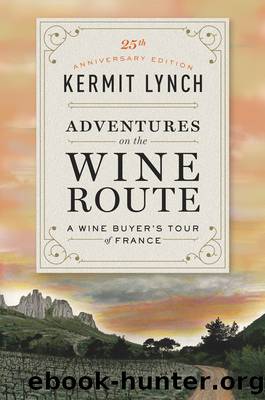Adventures on the Wine Route by Kermit Lynch

Author:Kermit Lynch
Language: eng
Format: epub
Publisher: Farrar, Straus and Giroux
NORTHERN RHÔNE
NOWADAYS, WHEN heading north from Provence, I hear Paul Tardieu’s passionate exclamation, “Once you know Provence, you don’t ever want to leave it. No one ever goes back north, no one!” If over the years I have grown attached to Provence, in terms of wine itself my heart belongs to the great reds of the northern Rhône. The best combine a reminder of the sunny Mediterranean with the more self-conscious, intellectual appeal of the great Burgundies farther north, which is not a bad combination. And these prized wines of the northern Rhône are France’s rarest: Hermitage has 300 acres planted in vines compared to 7,900 at Châteauneuf-du-Pape. Gigondas has 2,600; Cornas, only 130. To bring it into perspective, Vieux Télégraphe, a single domaine at Châteauneuf-du-Pape, has the same surface in vines as all of Cornas. Vieux Télégraphe’s vineyard can be cultivated by tractor despite the stones, whereas at Cornas a tractor would topple sideways down the hillside. Yet Châteauneuf-du-Pape and Cornas sell at about the same price, which explains why so many of the northern Rhône’s best vineyards have been abandoned: they must be worked by hand, and the pay stinks.
By autoroute, Cornas is only one hour from Châteauneuf-du-Pape, but everything changes.
That vast luminous Provençal skyscape is gone, and with it the expansive feeling it engenders.
In the north, you see what spawned the name Côtes du Rhône in the first place, the “hillsides of the Rhône.” Most vineyards have a view down to the river.
The talismanic olive and cypress trees disappear, and though one sees aromatic herbs like rosemary and thyme in the northern Rhône, they do not grow wild but must be cultivated.
Butter and cream replace olive oil in the cuisine of the northern Rhône. Garlic and tomato play a lesser role. This is the midlands, so the fish markets exude a less appetizing odor.
The northerners are supposedly harder workers, and more cerebral. They accuse their neighbors to the south of being lazy and superficial. But the southerners pity the uptight northerners, who are thrashed this way and that by their cold winter wind.
Those stonework walls that define the northern vineyard landscape are not to be found in the southern Côtes du Rhône, although farther south at Bandol the hills are once again adorned with them, so let no one slander the Provençaux for being lazy. The handmade walls transform the landscape to an extent the artist Christo would envy. Painstakingly constructed over the centuries, the dry-stone terraces bear witness to the value the ancients accorded these viticultural sites.
After the dizzying number of appellations in the south, the northern Rhône is easy. There are but a handful, including some of France’s noblest: Saint-Péray, Cornas, Saint-Joseph, Hermitage, Crozes-Hermitage, Condrieu, Château Grillet, and Côte Rôtie. And in contrast to the numerous grape varieties permitted down south, the northern Rhône reds are the result of a single variety, the Syrah. One would think that a blend of grapes could create a more complex range of aromas and flavors than a lone
Download
This site does not store any files on its server. We only index and link to content provided by other sites. Please contact the content providers to delete copyright contents if any and email us, we'll remove relevant links or contents immediately.
| Buying Guides | Cellars |
| Champagne | Collecting |
| Spirits | Whiskey |
| Wine | Wine Pairing |
| Wine Tasting |
Whiskies (Collins Gem) by dominic roskrow(42214)
101 Whiskies to Try Before You Die by Ian Buxton(42182)
Whiskies Galore by Ian Buxton(40332)
Craft Beer for the Homebrewer by Michael Agnew(17446)
Right Here, Right Now by Georgia Beers(3497)
Not a Diet Book by James Smith(2726)
Water by Ian Miller(2584)
The Coffee Dictionary by Maxwell Colonna-Dashwood(2531)
Kitchen confidential by Anthony Bourdain(2306)
Coffee for One by KJ Fallon(2007)
Smuggler's Cove: Exotic Cocktails, Rum, and the Cult of Tiki by Martin Cate & Rebecca Cate(1979)
Beer is proof God loves us by Charles W. Bamforth(1920)
Superfood Smoothie Bowls: Delicious, Satisfying, Protein-Packed Blends that Boost Energy and Burn Fat by Chace Daniella(1903)
Talking as Fast as I Can by Lauren Graham(1832)
Bourbon: A Savor the South Cookbook by Kathleen Purvis(1791)
A Short History of Drunkenness by Forsyth Mark(1720)
Eat With Intention by Cassandra Bodzak(1688)
Cocktails for the Holidays by Editors of Imbibe magazine(1626)
Colombia Travel Guide by Lonely Planet(1609)
